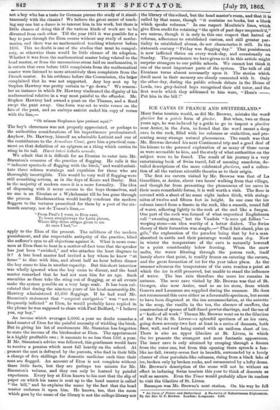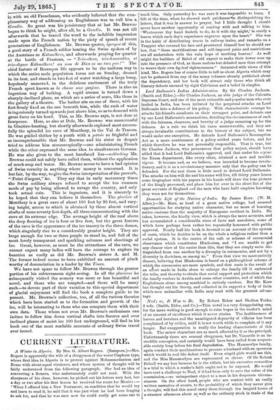ICE CAVES IN FRANCE AND SWITZERLAND.* MOST Swiss tourists would,
as did Mr. Browne, mistake the woril glaciere for a patois form of glacier. But when, two or three years ago, he was induced by a guide to go to inspect a glaciere near Arzier, in the Jura, he found that the word meant a deep cave in the rock, filled with ice columns or stalactites, and pre- senting many strange natural phenomena. The result was that Mr. Browne devoted his next Continental trip and a good deal of his leisure to the personal exploration of as many of these caves as were accessible to him, and the study of what authorities on the subject were to be found. The result of his journey is a very entertaining book of Swiss travel, full of amusing anecdotes, de- tailed descriptions of the more celebrated glacieres, and a collec- tion of all the variaus scientific theories as to their origin. • The first ice cavern visited by Mr. Browne was that of La Genolliere, at Arzier, about two hours' walking from that village, and though far from presenting the phenomena of ice caves in their more remarkable forms, it is well worth a visit. The floor is covered with a sheet of ice some eight inches thick, with stalag- mites of twelve and fifteen feet in height. In one case the ice column issued from a fissure in the rock, like a smooth, round fall of water, adhering lightly to the rock at the end like a fungus. One part of the rock was formed of what unpoetical Englishmen call "sweating stone," but the Vaudois "le scex qui follian "- weeping stone—an idea worthy of a better dialect. The Swiss theory of their formation was simple,—" Plus il fait chaud, plus ca, gele," the explanation of the paradox being that by hot a man absorbed in cattle and their pasturage would mean dry. Now in winter the temperature of the cave is naturally lowered to a point considerably below freezing. When the snow melts, the water filtering through the porous rock, itself barely above that point, is readily frozen on entering the cavern, and the great formation of ice for the year takes place. As the summer advances the temperature of the cave reaches a point at which the ice is still preserved, but unable to stand the influence of water. The less , rain therefore the more ice remains in autumn. The next cave visited by Mr. Browne was that of St. Georges, also near Arzier, used as an ice store, from which Geneva and Lausanne are supplied during the summer. He does not recommend this cave either as a favourable specimen, but seems to have been disgusted at the inn accommodation, at the anisette in the soup, the vanille in the tea, the absence of snuffers, the construction of spoons of half-fused pewter shavings, and the use of a " knife of all work." Thence Mr. Browne went on to the Glaciere of the Pre de St. Livres—a splendid specimen of an ice cave, going down seventy-two feet at least in a series of descents, both floor, wall, and roof being coated with an uniform sheet of ice. Thereis also an upper Glaciers at St. Livres, in which the ice presents the strangest and most fantastic appearance. The inner cave is only attained by creeping through a fissure from the outer one, but from this opening there spreads a fan- like ice-fall, twenty-seven feet in breadth, surrounded by a lovely cluster of clear porcelain-like columns, rising from a black lake of ice, broken only by broken rocks, and surmounted by a lofty dome. Mr. Browne's description of the scene will not be without an effect in inducing Swiss tourists this year to think of descents as well as ascents. Even the Times would probably allow its readers to visit the Glaciere of St. Livres.
Besancon was Mr. Browne's next station. On his way he fell
• Ice Canes of France and Switzerland. A Nfurative of Subterranean Explorauou. By the Rev. G. F. Browne. London ; Longman& 1o65. in with an old Frenchman, who evidently believed that the coin- plimentary way of addressing an Englishman was to call him a Gaudin. So great was his persistency that at last Mr. Browne began to think he might, after all, be a Gaudin. It was not till afterwards that he traced the word to the indelible impression made upon the French nation by the piety of speech of recent generations of Englishmen. Mr. Browne quotes, &propos of this, a good story of a French soldier hearing the Swiss spoken of by the Austrians as Kiihmelkers, and afterwards praying for quarter at the battle of Frastens, — " 7res-chers, tra-honorables, et ires-dignes Kiihmelkers ! an nonz de Dieu ne me tuez pas ! " The chief feature of Besancon life appears to be the uniform way in which the entire male population turns out on Sunday, dressed in its best, and stands in two feet of water watching a large bung, hopelessly unmoved, in the delirious excitement of the truly French sport known as /a chasse aux goujons. There is also an ingenious way of bathing. A rapid stream is turned down a sharply-inclined plane, on which are a series of seats, like those in the gallery of a theatre. The bather sits on one of these, with his feet firmly fixed on the one beneath him, while the rush of water is ingeniously turned upwards just above him, so as to descend with great force on his head. This, as Mr. Browne says, is not dear at feurpence. Here, as also at Dole, Mr. Browne was unsuccessful in Glaciers-hunting, but shortly afterwards explored most success- fully the splendid ice cave of Monthezy, in the Val de Travers. He was guided thither by a youth with a patois so frightful and se incomprehensible that Mr. Browne and his sister in despair tried to address him stereoscopically—one administering French while the other expressed the same idea in simultaneous German. He was also given to the most barefaced lies—unblushing Mr. Browne could not safely have called them, without the application of much soap and water. Mr. Browne seems to have a bad opinion of Swiss veracity in anything where money is concerned. It is but fair, by the way, to give the Swiss interpretation of the proverb, "Point d'argent," &c. They say that in early mercenary times the Swiss soldiery always refused to accept the too common mode of pay by being allowed to ravage the country, and only took actual coin. This is ingenious, and it is sincerely to be hoped that they can believe it themselves. The glaciere of Monthezy is a great cave of about 100 feet by 90 feet, and vary- ing height, access to which is obtained by three almost vertical shafts of some seventy feet depth, all three communicating with the cave at its extreme edge. The average height of the roof above the deep flooring of ice is four or five feet, but the great feature of the cave is the appearance of the ice tracery in the three domes, which singularly rise to a considerably greater height. They are large enough for two or three people to stand in, and full of the most lovely transparent and sparkling columns and sheetings of ice. Great, however, as must be the attractions of the cave, we cannot expect many ladies will have the courage to explore its beauties as coolly as did Mr. Browne's sisters A. and M. The former indeed seems to have exhibited an amount of pluck worthy of denunciation in a leader by the Times.
We have not space to follow Mr. Browne through the greater portion of his subterranean sight-seeing. In all the glacieres he subsequently visited the scenery was more or less beautiful and novel, and those who are tempted—and there will be many such—to devote part of their vacation to this special department of glacial enjoyment will find the book a complete guide to its pursuit. Mr. Browne's collection, too, of all the various theories which have been started as to the formation and growth of the ice, will be interesting to those who can compare them with their own data.- Those whom not even Mr. Browne's enthusiasm can induce to follow him down vertical shafts into fissures and over inclined planes of moist ice 100 feet underground, will find in his book one of the most readable accounts of ordinary Swiss travel ever issued.































 Previous page
Previous page